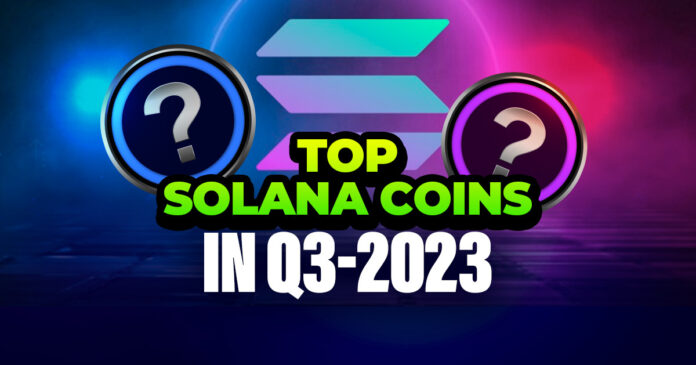Its remarkable speed and cost-efficiency even outpace Ethereum, the widely recognized leader in the field.
As we step into Q4 2023, it’s time to explore the Solana projects that hold promise for investment in the post-FTX era. Let’s take a closer look!
1) Marinade Finance ($MNDE)
Marinade Finance is a non-custodial liquid staking protocol meticulously built on Solana. Its primary objective is to provide a straightforward, secure, and frictionless method for staking SOL tokens across a vast array of over 130 top Solana validators.
This project had its genesis in March 2021 during a Solana & Serum Hackathon and achieved its mainnet launch on August 2, 2021. Since then, it has witnessed remarkable growth and adoption within the Solana ecosystem.
It's been a quick minute since the launch of our NFT mint
With only 1276 Chef NFTs left in the limited edition, let's recap on what they are, their utility, and how to mint one!
Keen to be a supporter of decentralization on Solana?
Grab yours 👇https://t.co/GVuNUoAlAk pic.twitter.com/xov5JWj6P1— Marinade (@MarinadeFinance) June 29, 2022
Marinade Finance’s pioneering feature lies in its ability to unlock liquidity while accruing staking rewards. In return, users who engage in staking SOL tokens receive a liquid token, $mSOL. This mSOL token steadily appreciates in value through staking rewards and can be freely utilized throughout the Solana ecosystem and its associated projects. This flexibility empowers users to participate in DeFi or convert to $SOL, giving them control over their staked assets.
Moreover, Marinade Finance also has its governance token, MNDE, signifying fractional ownership within the Marinade DAO. Holders of MNDE tokens have the privilege of minting a unique Chef NFT and actively participating in the governance processes of the Marinade protocol. It encompasses decision-making authority concerning treasury management, the delegation strategy, and the election of the executive team.
More recently, Marinade Finance rolled out a novel service called Marinade Native, designed to mitigate the smart contract risk associated with swapping $SOL for $mSOL while preserving an anticipated yield of approximately 7%. This service amalgamates features from liquid and direct staking, presenting a less precarious investment alternative for stakeholders.
More About Marinade Finance MNDE Price
$MNDE currently holds the 949th position in market capitalization, marking a significant shift from its ATH of $2.54. Its price has experienced a notable decline, plummeting by 98.36% to its current value of $0.04. This decline can be attributed, at least in part, to the impact of the FTX debacle.
One critical factor to evaluate when considering an investment platform is its Total Value Locked (TVL). According to DefiLlama data, $MNDE boasts approximately $107.5 million locked in TVL, reflecting substantial user engagement.
Marinade Earn Season 1 is here!
Get MNDE for staking SOL for mSOL or Marinade Native.
And earn even more $MNDE by referring others to the new Marinade Native.
🧵 Here are the details: pic.twitter.com/wXPUP2twjC
— Marinade (@MarinadeFinance) September 18, 2023
Notably, Defillama statistics indicate that Marinade Finance achieved an astounding peak TVL of $1.8 billion in November 2021, compelling evidence of its widespread adoption and utility within the crypto landscape.
Marinade Finance exemplifies the potential of liquid staking on Solana, offering a unique blend of liquidity, yield, and governance within the Solana ecosystem. Its commitment to widespread ownership and a diverse validator pool solidifies its position as Solana’s leading liquid staking protocol.
2) Lido ($LDO)
Next on our list is Lido. Although not strictly a Solana project, Lido is an important player in the Solana space. Launched in 2020, Lido is a liquid staking solution for PoS cryptocurrencies, including Solana. Notably, it supports staking on the post-Ethereum Merge consensus layer and other layer-1 PoS blockchains like Polygon, Kusama, and Polkadot.
📈 Lido Analytics: September 11 – 18, 2023
TLDR:
– TVL up +0.84% to $14.17b led by new ETH + SOL deposits.
– Lido led in net new ETH staking deposits with 68,096 ETH.
– stETH APR stable at 7d MA of 3.67%.
– (w)stETH in to DeFi pools increased 0.08%, currently at 2,986,444 stETH. pic.twitter.com/bYjIDUYjjk— Lido (@LidoFinance) September 18, 2023
Behind Lido’s operations stands a decentralized autonomous organization (DAO) that is pivotal in governing the protocol. This DAO empowers stakeholders to make key decisions, ensuring that the protocol remains aligned with their interests while maintaining decentralization.
Additionally, the DAO leverages Lido’s native crypto asset, $LDO, for governance, with each token conferring voting power commensurate with the holder’s stake.
What sets Lido apart is its adaptable and upgradable voting mechanism, which is distinct from other flexible protocols in the blockchain sphere. This unique feature allows the Lido DAO to implement governance changes without impacting the platform’s core functions.
More About LIDO
In the Solana ecosystem, staking on Lido offers benefits similar to Ethereum, including liquid staking, simplified staking, DeFi integrations, and immediate liquidity. Users can stake $SOL and receive $stSOL tokens in return, which can be traded or used as collateral on other DeFi platforms.
$LDO, the platform’s native token, is also crucial in rewarding users and maintaining the network. Currently ranked 34th in market capitalization, $LDO has performed relatively well in recent months, with an ATH of $7.30. However, in the broader period, it has experienced a decline of 78.38% to its current value of $1.52.
Lido on Ethereum Wave 5 Onboarding Update 🚀
The Lido Node Operator set will be growing by 7 operators.
Following a vote to onboard NOs proposed by the LNOSG, the Wave 5 onboarding round is complete with 9 new NOs joining the Lido set in Q3 👇 pic.twitter.com/OSAiBjh4IS
— Lido (@LidoFinance) September 21, 2023
$LDO demonstrates a strong presence in the DeFi landscape, with approximately $14.218 billion locked in TVL, according to DefiLlama. However, its footprint within Solana is smaller, accounting for around $53.95 million in locked value. Lido faces formidable competition in Solana’s liquid staking sector, with rivals like Marinade Finance and Jito vying for dominance.
Lido offers robust staking services, an intuitive user interface, competitive fees, and lucrative referral rewards. It provides liquidity across multiple cryptos and enjoys support from major DeFi players. Notably, Lido continues to dominate the DeFi sector, surpassing formidable protocols like MakerDAO regarding total assets locked.
3) Solend ($SLND)
Solend, a decentralized lending and borrowing protocol on Solana, has become a pivotal addition to the Solana ecosystem, filling a crucial financial niche. Since its launch, Solend has impressively attracted $100 million in deposits in just over a month.
Solend operates on an algorithmic system that determines interest rates and collateral requirements, allowing users to earn interest and leverage crypto assets, whether for long-term investments or short positions. The native token of Solend, SLND, provides exposure to Solana’s thriving DeFi sector.
User engagement is on the rise for @solendprotocol, a DeFi lending and borrowing platform on the Solana blockchain, as evident here: https://t.co/3485QxVFeK
Notably, about 30% of Solend's user base consists of NFT enthusiasts who have contributed to over 72,000 SOL in secondary… pic.twitter.com/Q1LHoAfuv3
— Nitin Shukla (@ergon50) September 3, 2023
At its core, Solend empowers users to engage in decentralized lending on the Solana network. Users can deposit assets into their Solend accounts and earn interest or collateralize these deposits to secure loans without extensive underwriting processes.
Solend operates as a self-propelled autonomous app, streamlining the lending process through smart contracts. These contracts consider various factors, including borrowing limits and interest collection.
Solend sustains its operations by charging protocol fees on loans, which also contribute to an insurance fund for the platform. Users benefit from cost-effective borrowing and trading of crypto assets, thanks to the liquidity ensured by Solend’s treasury, which offers insurance coverage in case of exploits or hacks.
More About Solend
However, Solend has had its fair share of challenges, particularly in 2022. Concerns arose over the liquidation of a whale account, sparking worries among Solana users about a possible market crash. Additionally, the platform experienced an Oracle exploit in November 2022, resulting in $1.26 million in bad debt. Here are some of its use cases:
- Facilitates a wide range of financial services.
- Accepts any SPL token as collateral for borrowing.
- Integrates automated markets for high liquidity.
- Offers users substantial interest and additional rewards.
- Features multiple isolated and permission pools alongside a global liquidity pool.
- Provides an intuitive, visually appealing dashboard.
Solend holding strong as a top 3 Solana DeFi protocol! pic.twitter.com/v0HDSPoslr
— ◉ Solend (@solendprotocol) September 14, 2023
$SLND, Solend’s native token, currently ranks 642nd in market capitalization. It has demonstrated resilience during bearish market conditions. Furthermore, $SLND has an ATH of $16.65 and is now trading at $0.55. Similar to Marinade Finance, Solend faced challenges linked to the FTX collapse. Currently, DefiLlama data indicates around $45.67 million in TVL for the project.
Solend has introduced the potential for DeFi on Solana, offering various opportunities for users to enhance their profits. Despite encountering vulnerabilities from the whale incident and an Oracle hack, the protocol’s developers have showcased their capability to tackle these challenges effectively. Solend’s lending protocol is intriguing, but caution is advised, especially when dealing with significant funds.
Conclusion
In this environment, where Solana remains undervalued, investors and developers have a unique opportunity. While Solana might not always command the spotlight in the broader crypto landscape, these applications provide compelling evidence that development on this blockchain is not only alive but thriving.
Considering this, keeping a vigilant eye on Solana and the remarkable projects taking shape within its ecosystem is essential. And AltcoinBuzz can be your reliable companion on this journey! So stay tuned for more!
Disclaimer
The information discussed by Altcoin Buzz is not financial advice. This is for educational, entertainment, and informational purposes only. Any information or strategies are thoughts and opinions relevant to the accepted levels of risk tolerance of the writer/reviewers and their risk tolerance may be different than yours. We are not responsible for any losses that you may incur as a result of any investments directly or indirectly related to the information provided. Bitcoin and other cryptocurrencies are high-risk investments so please do your due diligence. Copyright Altcoin Buzz Pte Ltd.





























